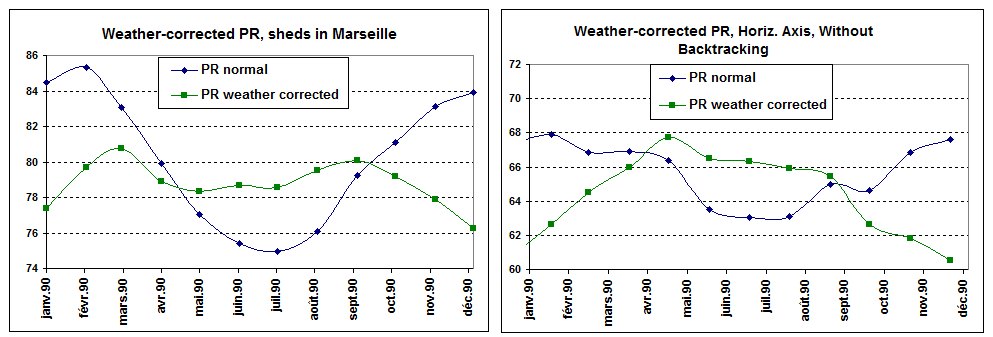See also the previous page Normalzed Performance index.
The Performance Ratio is the ratio of the energy effectively produced (used), with respect to the energy which would be produced if the system was continuously working at its nominal STC efficiency. The PR is defined in the norm IEC EN 61724.
In usual Grid-connected systems, the available energy is E_Grid. In stand-alone systems, it is the PV energy effectively delivered to the user, i.e. E_User - E_BackUp. In pumping systems, this is E_PmpOp.
The energy potentially produced at STC conditions is indeed equal to GlobInc * PnomPV, where PnomPV is the STC installed power (manufacturer's nameplate value). This equivalence is explained by the fact that at STC (1000 W/m², 25°C) each kWh/m² of incident irradiation will produce 1 kWh of electricity.
Therfore for a grid-connected system:
PR = E_Grid / (GlobInc * PnomPV)
Interpretation
The PR includes the optical losses (Shadings, IAM, soiling), the array losses (PV conversion, ageing, module quality, mismatch, wiring, etc) and the system losses (inverter efficiency in grid-connected, or storage/battery/unused losses in stand-alone, etc).
Unlike the "Specific energy production" indicator, expressed in [kWh/kWp/year], this indicator is not directly dependent on the meteo input or plane orientation. This allows the comparison of the system quality between installations in different locations and orientations.
Namely, the PR is not dependent on the PV module efficiency. As an example an amorphous module and a crystalline high-efficiency module will lead to comparable PR. Only the low-light performance and temperature dependency will induce differences.
A tracking system will have a similar PR than a fixed sheds arrangement. Even sometimes slightly lower because the array temperature (related to GlobInc) may be higher.
With equivalent yield performances, a tracking system with backtrackîng will have a significantly higher PR than a non-backtracking one, because the effective irradiance in the collector plane is lower (due to the not optimal orientation). In a conventional tracking system the mutual shadings highly affect the PR.
In big systems (sheds or trackers), the far albedo is only "seen" by the first row, so that its effect is negligible (shading factor = (n-1)/n, where n = nb. of sheds). Therefore if you increase the albedo in your project, the GlobInc value will increase, the albedo loss will increase for a same production, and the PR will decrease.
Self-consumption and storage
The PR is an indicator of the availability of solar energy for final uses. Therefore, when a part of the energy is used internally (E_Solar), this should obviously be included in the PR evaluation. With systems including a storage, the storing losses (battery charge/discharge inefficiency, DC-AC and AC-DC conversion devices) should also be included in the PR.
Therefore in the above formula, the E_Grid should be replaced by E_Grid + E_Solar :
PR = (E_Grid + E_Solar) / (GlobInc * PnomPV)
The PR is an important metric in the PV indusrtry, it is often used as a contractual condition / warranty when commissioning a PV system, or for the verification of the annual yield.
This is not an easy task, as the PR is not constant over the year, and the effective GlobInc value is not always available.
Weather-corrected PR
For short time analysis (commissioning, one-week tests), a NREL paper proposes a "Weather-corrected Performance ratio".
The objective is to get rid of the seasonal variations of the PR, mainly due to the varying array temperature. Other weather contributions like irradiance level, wind velocity, varying soiling, etc are not taken into account in this approach.
The proposition is to define an average array temperature, which is an average over all operating hours in the year, weighted by the incident irradiance GlobInc.
Then for a specified period, the PR (corr) is defined by the following equation:
PR (corr) = E_Grid / ( PNomPV * Σ hours ( GlobInc / GRef * (1 - muPmpp * (Tarray - TArrayAver) )
Where :
- GlobInc = incident irradiance in hourly values
- GRef = 1000 W/m²
- muPmpp = Pmpp temperature coefficient of the PV module
- TArray = Array (cell) temperature of this hour
- TArrayAver = Array temperature average over the whole year, weighted by GlobInc, i.e.:
TArrayAver = Σ hours (GlobInc * TArray) / Σ hours (GlobInc)
Mathematically, if the TArrayAver is calculated with the same data, the yearly PR(corr) value should be equal to the yearly PR.
We have implemented this in the PVsyst version 6.74. However the result is not so convincing, because in most PV systems, other contributions are season-dependent.
With shed-systems, applying this PR correction seems to over-correct the PR seasonal behavior. This is due to the mutual shadings, which are more pronounced in winter.
This correction is almost unuseable with tracking systems, as the seasonal variations due to tracking are largely dominating the temperature effect.
Therefore these results will be available on the report only when you ask it in the "Report Preferences", menu "Settings" in the Report editing window.
